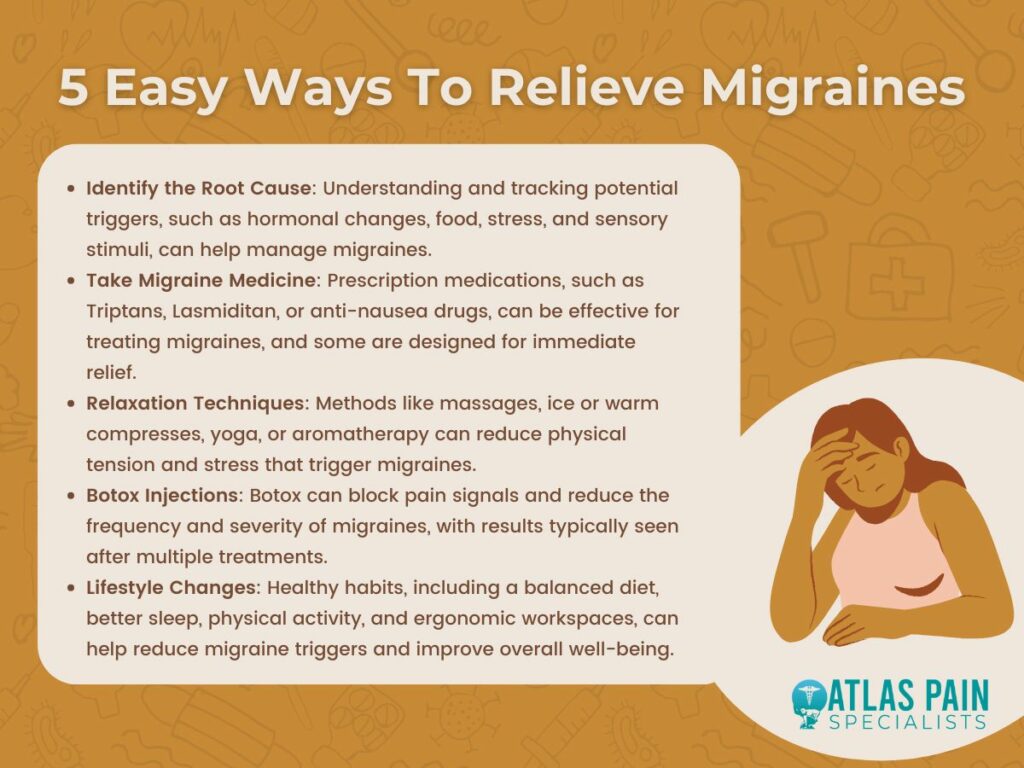

5 Easy Ways To Relieve Migraines
Migraines can make it impossible to focus, make decisions, and complete the most basic of daily tasks. Your symptoms may include nausea, visual disturbances, and symptoms that are so severe that the only thing you can do is lay down.
Unlike the average headache, your preferred over-the-counter pain reliever may not provide relief. Here are 5 easy ways to relieve your migraines.

#1 Identify The Root Cause
Migraines are often recurring so you must identify the root cause. Keeping a journal may help you identify the trigger or cause, but you may also need to work with a physician.
Once the root cause is determined you can take a proactive approach to minimize both frequency and severity.
Common causes include:
- Hormonal changes, especially in women. For example, during your monthly menstrual cycle, pregnancy, and menopause.
- Wine, alcohol, caffeine, cheese, salt, processed, aspartame, MSG, and other foods and food preservatives may trigger headaches.
- Extreme stress, anxiety, and depression.
- Sensory stimuli such as flashing lights, bright lights, loud noise, synthetic perfume, paint thinner, and other auditory, visual, and aromatic stressors.
- Changes in the weather or barometric pressure.
- Physical stressors such as sleep deprivation, physical exertion, poor posture, and back, neck, and shoulder tension.
- Migraines may be a side effect of oral contraceptives, nitroglycerine, hormone therapy, and other prescriptions.
- An accident or injury may cause acute or chronic headaches or migraines.
#2 Take A Migraine Medicine
There are a couple of over-the-counter migraine medications, but your physician may prescribe something stronger.
Some prescriptions are designed to be taken as soon as you feel a migraine coming on, while some are taken once it has set in.
A few options your physician may prescribe include:
- Sumatriptan injections may be prescribed for at-home use to be used at the first sign of a migraine.
- Triptan prescriptions such as Imitrex, Tosymra, and Maxalt can be taken as oral pills, shots, or nasal sprays to block the pain pathways to the brain.
- Lasmiditan may be prescribed as treatment for those who will not need to drive or operate heavy machinery as the side effects include drowsiness and dizziness.
- Ubrogepant and other CGRP antagonists may be effective for acute migraines caused by accident or injury.
- As-needed opioids may be prescribed to patients who cannot use other migraine medications.
- Anti-nausea drugs may be prescribed if the migraine is accompanied by aura, vision disturbances, nausea, or vomiting.
#3 Relaxation Techniques
If your trigger is physical, sensory, or emotional relaxation techniques may help. There are countless relaxation techniques to choose from, including:
- If your neck, back, or shoulders are tense applying a warm compress, taking an Epsom salt bath, or sitting in a steam room may relax your muscles and alleviate your pain.
- Gentle but targeted stretches and self-massage or professional massage therapy may relieve tension that leads to migraines.
- An ice compress to the neck, head, shoulders, or other inflamed areas may minimize your symptoms.
- If bright light triggers your migraines, always wear sunglasses outdoors. If extended periods of time sitting in front of electronic screens trigger migraines, wear blue light glasses.
- If stress or anxiety are triggers, incorporate yoga, meditation, and relaxation exercises into your weekly routine.
- If synthetic scents are a trigger, carry a neutralizing aroma such as coffee beans in a plastic baggie that you can sniff when triggered. On the flip side, natural essential oils such as peppermint, lavender, rosemary, chamomile, and eucalyptus may counterbalance scent triggers and promote overall relaxation.
- If uncontrollable external noise such as construction is the cause, play white noise, soothing sounds of nature, put on earplugs or noise-cancelling headphones, or go somewhere quieter.
#4 Botox Injections
Anti-aging may be the first thing that comes to mind when you think of Botox, but Botox injections can also be used to treat headaches, migraines, and pain.
Botox works as a nerve block that stops your neurotransmitters from communicating pain to the nerve endings in your head and neck.
A pain management physician will determine which nerves in your head and neck require a series of injections. The injections are more like pinpricks than a full injection. You will likely need 20 to 30 small injections per treatment.
It can take up to 3 weeks to minimize your migraines and the injection lasts about 12 weeks. Maximum results are experienced between the 3rd and 5th series of injections.
Studies find that 70% of patients experience a 50% reduction in the frequency of their headaches and migraines. When a migraine does arise, the severity of symptoms is also likely to be reduced.
#5 Lifestyle Changes
In addition to the tips above, you may need to make a series of lifestyle changes. The changes you make should be personalized to minimize your individual triggers. This may include any combination of:
- Improve your nutrition by choosing a diet that is low in caffeine, alcohol, refined sugars, and processed foods. Your diet should be high in healthy whole foods, low-processed meats, nuts, seeds, fruits, vegetables, and whole grains.
- Creating a sleep schedule where you head to bed and wake up within the same 30 minutes each day can improve the quality of your sleep, as well as your whole-body health.
- Increasing your daily and weekly physical activity can minimize physical and mental stressors. This includes stretching, workouts, and targeted counter stretches to minimize the negative effects of repetitive motions such as your daily electronics use.
- Investing in office ergonomics and a convertible or standing desk can minimize neck, back, and shoulder pain. Pay particular attention to the height of your digital screens.
- Proactively schedule self-care into your weekly routine. This can include massage, meditation, time in nature, talk therapy, alternative therapy, your favorite hobbies, and more.
Want To Learn More About Botox?
A pain management specialist is a physician who explores targeted and personalized solutions to pain. As with all types of pain, identifying and treating the root cause is key—as well as alleviating current pain. Reach out to Atlas Pain Specialists in Phoenix today to personalize your approach to treating migraines.
About Dr. Sean Ormond



